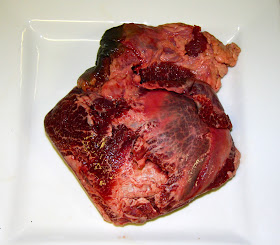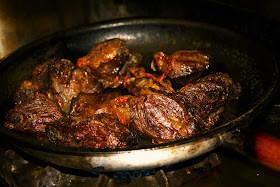Ragù Guardaporta is a traditional dish from Napoli. Guardaporta means "doorman" in Italian and the dish was originally a stew that was slowly braised in a pot by hotel doormen and other staff in their living quarters while on duty. Ragù Guardaporta was a stew that could cook on it's own with little or no attention. Any cheap cut of beef, pork, veal, lamb, or even horse meat was stewed in a "doorman's ragu".
The word ragu is derived from the French verb ragoûter, which means "to revive the taste". Ragù Napoletano and Ragù alla Bolognese are similar Italian meat stews served on pasta, and many of the ingredients are the same.
 |
| whole raw veal cheek |
I decided to make my version of guardaporta with veal cheeks, a cheap and increasingly popular cut of meat. Cheeks are a tough cut containing a lot of collagen and are perfect for this slow braising style of dish. The meat softens as the collagen breaks down into gelatin and enriches the sauce with a glazed goodness like osso buco or oxtails. It is not necessary to fuss with the cheeks before using them as many recipes indicate. I just wash them, cut them into 4 or 5 pieces and remove the excess fat and cartilage.
 Season and brown the cheeks well in a pan and deglaze the pan with a glass of red wine and set aside. Rough chop onions, celery, carrot, and fennel and cut some side bacon into 1cm pieces.
Season and brown the cheeks well in a pan and deglaze the pan with a glass of red wine and set aside. Rough chop onions, celery, carrot, and fennel and cut some side bacon into 1cm pieces. Saute the vegetables and bacon with a good amount of garlic until the onions become translucent and the bacon begins to release it's fat. Add the cheeks, red wine, a couple of bay leaves, tsp of oregano, some rosemary, hand crushed plum tomatoes with juice, and a small handful of dried porcini mushrooms. Add some water so the cheeks are just covered.
Saute the vegetables and bacon with a good amount of garlic until the onions become translucent and the bacon begins to release it's fat. Add the cheeks, red wine, a couple of bay leaves, tsp of oregano, some rosemary, hand crushed plum tomatoes with juice, and a small handful of dried porcini mushrooms. Add some water so the cheeks are just covered. Slowly simmer the dish for around 3 hours, stirring occasionally. The cheeks should be fork tender and surrounded by a thick rich sauce. Add a handful of kalamata or niçoise olives and serve over tagliatelle or pappardelle with fresh parmesan and olive oil. This dish is very hearty and a small amount of ragu will go a long way.
Slowly simmer the dish for around 3 hours, stirring occasionally. The cheeks should be fork tender and surrounded by a thick rich sauce. Add a handful of kalamata or niçoise olives and serve over tagliatelle or pappardelle with fresh parmesan and olive oil. This dish is very hearty and a small amount of ragu will go a long way.
